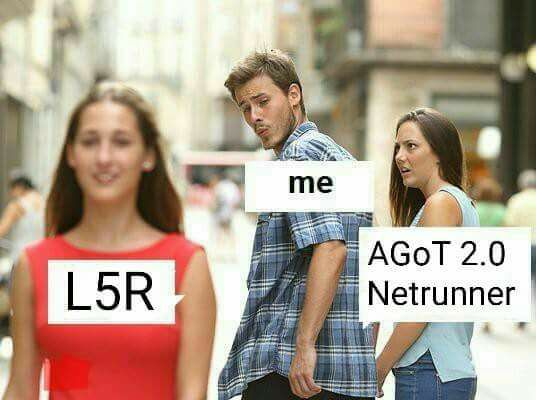(Credit for image: Spicy 2.0 Memes Facebook Group)
Hello and Welcome to the Wardens of the Midwest!
If this is your first time visiting the site (presumably due to your interest in Legend of the Five Rings, otherwise known as ‘L5R’ from here on out), my name is Joe from Cincinnati. The beginning of this article is a quick history on my experience both as an L5R CCG player and as a Game of Thrones player. If you don’t care (which I wouldn’t blame you, to be honest),you can skip to the header below labeled “Skip to Here if You Don’t Care Who I am.”
…
…
Alright, now that all the jerks are gone, I can tell you a bit about myself :).
I have played A Game of Thrones LCG 2.0 since it was released in 2015 and started writing articles for it a short time after that, hence the name of the website, Wardens of the Midwest (Cuz I’m from Cincinnati :D). My friend Mickey named the website based on Game of Thrones and then promptly quit the game, so I blame him for its lack of relevance to L5R. Changing the name now would be too complicated and I’m not managing two websites, so we’re just gonna mash both games together on this one site! 🙂
The Thrones Community knows who I am not because I am a great card player or because I am a serious competitive player or anything. They only really know me because I post a lot in the social media portals of the game and I played the Night’s Watch and wrote articles about the Night’s Watch during a time (Core set and most of the first cycle) where they were considered “unplayably bad.” So it kind of became a joke within the community that I was “The Night’s Watch Guy” or, perhaps more accurately, “that idiot who keeps playing The Night’s Watch.” Clan Loyalty was a foreign concept to many Game of Thrones players, so it was not only bizarre that a person would play a bad faction, but also that they would play JUST that one bad faction. This made me a fairly memorable member of the community, despite my inability to win anything of significance (I did win a store championship during the second cycle though :P)
Why did I play a faction that was considered so bad? Well, I started playing The Night’s Watch because, to make a long story short, they had a different style of play than the other 7 factions and I liked that. The Wall was kind of like an alternate win condition in that, rather than gaining power by initiating and winning challenges, I was able to gain power by defending all of my opponent’s attacks each round. It felt a lot like an honor running deck from the old L5R CCG, which greatly appealed to me as a CCG player. I played Crane honor in Samurai edition and Lion Honor/Military switch for the remainder of my time playing the game after Samurai edition (up to Ivory edition, at which point my meta dissolved, as I imagine many did). So the ability to win my own way rather than playing into my opponent’s strengths felt like home to me. Of course, my opponents hated it, but honor runners are used to that feeling, am I right? 😉
So when the new LCG version of L5R was gearing up for its release in April through August, and Gencon right around the corner, the first thing I had to do was pick a clan. I wanted to play a clan that was able to win in multiple ways, because that was my playstyle in the past and it was a playstyle I wanted to maintain going into the LCG, if possible. Of course, almost every Game of Thrones player, when L5R was officially announced back in April 2017, immediately assumed I would play Crab because they are so similar (in lore) to the Night’s Watch. I personally was not interested in pidgeon holing myself before I even played the game. Like I said, I was a Crane and Lion player in the Old CCG so I felt no need to default to Crab just based on my experience in a completely separate game and fantasy world.
So what clans were best at attacking their opponents from multiple angles?
Scorpion seems to have a powerful dishonor strategy as well as good political strength to pressure dishonor + ‘conquest’ (what I will call the win strategy that entails breaking the Stronghold Province) simultaneously. Crane and Lion both looked like they have a chance at honoring to 25 given the right circumstances and even Phoenix looked like they had a dishonor win condition brewing, all while maintaining a fairly powerful conquest strategy as well.
…And then we came back around to Crab. I love their ability to pressure dishonor with the likes of Intimidating Hida and Watch Commander while also threatening conquest victory through military conflicts. And, on top of that, they had several cards (and hopefully more in the future) that were meant to be played defensively. Predictably, this spoke to my nature as a Night’s Watch player and I ultimately decided, against all odds, to go with Crab at Gencon (womp womp womp). Somehow, I managed to go 5-0 in the Kiku Matsuri and ended up being a Crab Hatamoto, so now I no longer have to wonder what clan I’ll play! The decision has been made for me! XD
So, why am I writing this article? Well, like I did with Night’s Watch in A Game of Thrones, I am interested in representing the Crab Clan, as one of their first Hatamotos, in the coming years with strategy articles, theory crafting and all that (assuming, of course, that people give a shit about what I think. And assuming I have time to do so.)
Skip to Here if You Don’t Care Who I am
So, to start things off, I thought I’d do a basic strategy article for Crab where I define what is going through my head when I’m playing Crab and what my goals are during the game. So let’s start with the deck list. (List updated post Worlds now that we’re Keeper of Earth).
Shiro Nishiyama
Keeper of Earth
Fertile Fields Air
Ancestral Lands Earth
Meditations on the Tao Fire
Shameful Display Void
Rally to the Cause Water
Influence: 13/13
Dynasty Deck (40)
Character (33)
3x Borderlands Defender
3x Hida Guardian
3x Hida Kisada
3x Hiruma Yōjimbō
3x Intimidating Hida
3x Kaiu Envoy
3x Kaiu Shuichi
3x Keeper Initiate
3x Shrewd Yasuki
3x Steadfast Witch Hunter
3x Vanguard Warrior
Holding (7)
2x Favorable Ground
1x Funeral Pyre
3x Imperial Storehouse
1x Karada District
Conflict Deck (40)
Event (23)
3x Assassination
3x Banzai!
2x Captive Audience ///// /
2x Charge!
3x Court Games
2x Rebuild
2x Spies at Court
3x The Mountain Does Not Fall
3x Way of the Crab
Attachment (15)
3x Fine Katana
3x Ornate Fan
3x Reprieve
3x Spyglass ///// /
3x Watch Commander
Character (2)
1x Iuchi Wayfinder /
1x Stoic Gunsō
The basic premise behind this deck:
Control your opponent’s board. Control their honor. Control their hand.
Sounds super easy right? While I don’t think it’s possible to control all 3 simultaneously on a consistent basis (unless you consistently play against bad players), I do think it is very reasonable to control 2 of these 3 game elements of your opponent’s throughout the course of an average game, based partly on the choices they make during the game.
In this article (and the second part of this article) I’ll go over these three ideas and the cards/strategies/priorities that will facilitate this, as well as evaluate the splash’s place in this strategy.
1. Control Your Opponent’s Board
Crab has one of the best board control cards in the entire game in The Way of the Crab. For the price of 1 fate, 1 card (the event played) and a character of your choice (typically a small one like a Kaiu Envoy or Eager Scout), your opponent has to sacrifice one of their own characters. On the surface, this doesn’t seem so bad for your opponent. They would just discard a similarly weak character, as it is their choice who leaves play. However, there are ways to isolate your opponent’s characters such that this causes maximum damage.
But first, let’s rip the band-aid off real quick: YES YOU CAN PLAY WAY OF THE CRAB DURING THE DYNASTY PHASE.
Don’t let anyone tell you differently. This has been verified by Nate French as well, if you need any more proof. So, if you are first player and you purchase an Eager Scout (or some other low cost character) as your first action, your opponent can either play a low cost character as well or, if they are a new player and/or not familiar with Crab’s capabilities, they may buy a 3+ cost character as their first action. That means, for your second action, you can play Way of the Crab to remove your Eager Scout and the only character they can remove is the character they just bought. This is not only insane economic and board tempo, but it’s also really disheartening for your opponent and they may tilt before the game even really begins. Especially if it was their Clan Champion! For Game of Thrones players, you remember the first time you set up your 7 cost character alone and they got Marched to the Wall? That’s the kind of thing we’re going for here.
As for ways to isolate your opponent’s best characters in a non-janky Dynasty phase action way, the first is obvious: Ring of Void.
If your opponent plays one strong character with 2 fate and one lower priced character with 1 fate, a Ring of Void wouldn’t ordinarily be all that impactful. You could remove the fate on the lower cost character so that they leave during the fate phase or you could remove 1 fate from the big character so that the following turn that character has no fate on them. Decent options, but not game breaking.
Well, in combination with Way of the Crab, a Void conflict suddenly becomes much more scary. If you can remove the fate on the lower cost character, such that they leave play during the fate phase, that leaves your opponent’s board to be just their big character. The action window in the fate phase is after fate is removed and fateless characters leave play. This means that, if you have a cheap character like an Eager Scout, with 1 fate on them during the conflict phase, they can survive through the fate phase and be used at the end of the fate phase to remove whatever character your opponent has left which, in this case, would be the big character since he has no other low cost characters to sacrifice in their place. I’ve even reprieved low cost characters before to make them last until that action window in the past if this situation unexpectedly arrives.
Because of that action window, buying a Kaiu Envoy or an Eager Scout with 1 fate on him can potentially be a very good play. An educated opponent immediately will think you have Way of the Crab in hand. Their options (beyond having a means to cancel or otherwise stop the Way of the Crab) become A.) play around it by overloading their characters with fate such that a Ring of Void+Way of the Crab doesn’t remove their prized character at the end of the phase (making it so that they can’t play as many characters this round) or B.) ignoring it and leaving themselves open to a possible board wipe. Either way, you gain a significant advantage over them at the cost of 1 fate on the Eager Scout. Even better if you were just bluffing!
The second is less obvious but even more powerful, especially when combined with the Ring of Void: Assassination.
If your opponent, later in the game, has a 4 or 5 coster with 2 fate and two 1 or 2 costers that both have 1 fate on them , the Ring of Void no longer opens their big character up to a Way of the Crab(unless one of their low costers happens to run into a Meditations on the Tao 😉 ). However, if you Void one of the low costers and Assassinate the other, suddenly their big character is wide open during the fate phase again!
These strategies, in combination with cards like Vanguard Warrior and Reprieve, ensures the quality of your characters on the board will often be better than your opponents’ throughout the course of the game, giving you a steep advantage in the coming conflicts. You can pair this superior character quality with cards like The Mountain Does Not Fall (that allows your characters to participate in multiple conflicts in the same round) to further push your character quality and quantity and win conflicts and, ultimately, the game via sheer numbers.
Recent studies of the comments on other bloggers’ Facebook posts leads me to believe that people don’t like super long articles so, in order to maintain the attention of you readers, I will call it a day here and post the second part of this article tomorrow-ish. In the second part, we will cover how you can control your opponent’s honor and hand, as well as evaluate the splash cards in relation to this strategy.
I hope to see you guys there! 😀
Edit: Here is the link to the second part of this article.




